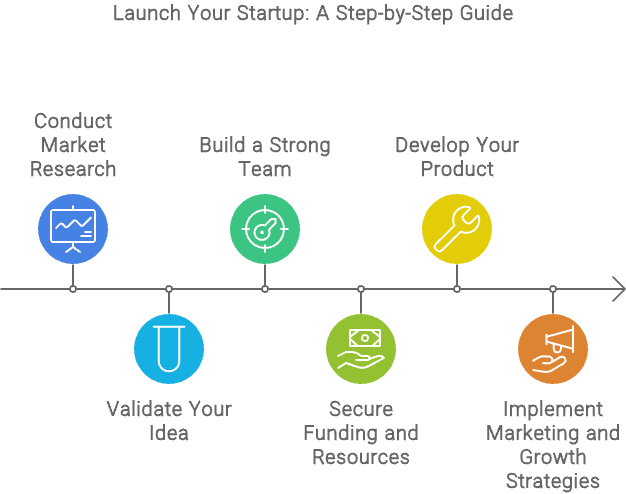When I was 10 years old, I had an idea for a new board game.
Every kid would LOVE it.
I built a prototype, the small figurines, the differently colored squares on the board, the cards with impossibly complicated rewards and punishments.
I even came up with a name that would sell well in stores…
… That was until I found some nerd had beaten me to it.
My entrepreneurial dreams had been shattered.
Still, I could never forget how amazing that spark felt. I knew my life was about chasing those wild ideas, no matter the cost.
So why swap a cozy job for the chaos of a startup?
Simple: there’s no rush like seeing your idea come to life. Having your own business means that you have autonomy and creative freedom and can make an impact on the life of so many people.
Without that initial spark, how can you make a fire?
Think that big companies have the upper hand? Nope, they’re slower than a sloth trying to get a drink at a bar.

Startups, defined by their focus on a single idea or business model, implement new ideas much faster because they simply have nothing to lose. They don’t have a colossal brand to protect or layers of bureaucracy to wade through.
However, it’s how well they implement the idea, how quickly and accurately they target their audience, that really matters. Quality execution wins, not just a stellar idea.
Startup Mania is Real! Recent global data shows university students are ready to hustle:
Early-stage startup investments surged from $72.8 billion in 2017 to $208 billion in 2021.
Alright. Let’s be honest here and not pick only optimistic facts:
But! Emerging technologies like AI continue to attract significant investment.
And after every downturn—be it economic, social, or personal—comes a rebuilding phase where creativity thrives, opportunities multiply, and bold new ideas take the stage.
Brace yourself; entrepreneurship is tough. Long hours, massive responsibility, and years to see rewards. Sounds delightful, right?
But the startup advantages are unbeatable:
Having your own business means you make the calls, solve the problems you care about, leave a positive mark on the world, innovate without bureaucratic BS, make a ton of money, and grow as a person.
That doesn’t mean you can do anything you want. Want a vacation anytime? Sure! Stay on vacation when the company’s sinking? Hell no.
If you want to be successful, you have to focus on the needs of users, not you. Without a user-centric approach, you’ll alienate new customers, like bad breath in an elevator. Being your own boss doesn’t mean you’re not obligated to the market, clients, and your team.
I go SO much deeper about all of this in my…
Free Startup Launch Roadmap eBook!
It’s a step-by-step guide designed to quickly show you EVERYTHING you need to work in, if you want to build a successful business asap.
It won’t build your business for you (I mean, come on, it’s a book), but it’ll show you exactly where you need to put your focus right now.
You can check it out here:

If the board game had gone big at 10, I’d have crumbled at the first problem. Seriously.
In business, surprises lurk around every corner. The right startup mindset? Solid. You’re not running to Mommy, at the first sign of difficulty. You’re forging ahead like a fearless warrior who has:
You can’t run away when problems arise, and there is definitely no one to run to. You. Are. On. Your. Own. Feels like sinking without a lifebuoy? Welcome to entrepreneurship! It’s going to be one hell of an emotional rollercoaster.
Assess yourself honestly. Which traits propel you? Which hold you back? It’s okay to not feel you’re completely ready to be the big boss right now. Find the areas you can improve in and have a plan to get better in those. For example, I don’t wet my pants anymore when the market declines because I’ve become more resilient and adaptable to those changes.
The best entrepreneurs embrace hardship over a comfortable life. Get out of your comfort zone. Hunger breeds innovation, so you need to put yourself in that position to reap the big breakthroughs.
So, let your passion fuel you to tackle real problems that bug people. These can range from huge global messes (like climate change) to everyday annoyances (like that annoying app that never works).
Trying to be a corporate superstar and a startup rockstar? It’s possible, but it’s all about smarts and not going completely nuts. It starts with figuring out what makes you tick and how that fits with your current gig. Juggling a job and a startup can work but be smart about your time and money.

Whatever your business, there are things you need to get right if you want to see real progress. While this is not a step-by-step guide to launching a startup, here are some startup success strategies:
Think you know your target audience, competitors, and industry trends? Think again. Get down and dirty with market research. Not sure what business idea to go with? Brainstorm supply and demand. Demand is what people need, the gaps in the market where a problem hasn’t been solved yet, supply is the tools and skills you bring to the table. You can find interesting niches for your business by asking what is missing in the market and what you can solve.
Building a startup is like throwing a party – you need to know who to invite!
Ask yourself: “Who’s dealing with this crap?”
Figuring out who needs your solution is crucial for turning your idea into a cash machine (or, you know, at least a viable business).
Then check what’s Already Out There? Research existing solutions. Are they any good?
Spot the gaps, and see how your startup can do it better.
From idea to prototype to launching the product, there’s no point diving in unless there is a real market need. Having an idea isn’t enough. Test it. Validate it. Your product needs to be constantly refined to meet the goals and challenges of potential customers. Make sure you’re actually solving a real problem for them. Time to chat with some folks, not just your own thoughts. 😉
To ensure your startup thrives, begin with customer discovery and validation.
Start with a wild guess. Maybe you think small business owners are drowning in disorganized spreadsheets. Like, they’re practically swimming in cells and formulas. This is your “hypothesis.”
Many startups (some of mine too) died due to lack of demand.
Just because the “problem” was not really a major pain point!
You need a kickass team with complementary skills and a positive company culture. You want to avoid individual limitations hurting the business, so do a deep analysis before launching, especially if you have co-founders. While SWOT analysis is a common framework, I like to use CLEAR (Capabilities, Limitations, Expectations, and Risks). More on that in my Make It CLEAR Course. Shameless plug? Maybe.
Networking also unlocks partnerships, investments, and that co-founder you’ve been dreaming of. Find events and meetups to learn from others’ mistakes and grow your skills. Find those who’ve launched successful businesses. Check hackathons, competitions, and guest lectures nearby. Programs like Techstars and Y Combinator throw parties (well, kinda).
How to Network (Without Being Weird):
Before you start throwing cash around like a drunken sailor, you need a plan. How are you going to pay for this thing? Are you going to bootstrap or seek investors? You’ll have to decide how to fund and allocate resources to reach your company’s goals.
Before you even think about funding, understand your finances. What’s coming in? What’s going out? What do you own? What do you owe? Know your profit, loss, assets, liabilities, and the total cost of getting your startup off the ground. This isn’t just boring accounting stuff – it’s crucial!
Again, I’m talking about it a lot in my Make It CLEAR Course. And there are cool templates that help you assess that.
Explore Some Funding Options:
Developing your product is an iterative process. Start with a minimum viable product (MVP) and then iterate based on user feedback. Build, test, refine. Rinse and repeat. Want more on this? Check out our recent article.
Craft compelling messaging that hits so you convert leads into real customers. Create a killer strategy to scale up your business. We’ve got a longer article on making a Go-To-Market plan.
Too much advice leads to analysis paralysis. Though it’s often beneficial, trying to follow all of it can quickly become overwhelming, especially for small businesses or solopreneurs. They don’t have the time, money, or people to implement it all. The challenge is to figure out which recommendations are truly necessary now and which can be saved for later. Personalized guidance from consulting services or experienced entrepreneurs can help identify these areas.
Heads up, obsessing over every YouTube video doesn’t help. There’s no one-size-fits-all solution. Tailor your strategy to your business stage and needs and take into account positioning factors, like whether your business excels in cost-saving, quality, speed, or flexibility. By setting up basic KPIs from the start, you can properly track progress and make better long-term decisions.
Entrepreneurship isn’t for everyone. But in my humble opinion, the rewards by far outweigh the challenges.
If you’ve ever felt that spark of a business idea, don’t run away from it. Explore your entrepreneurial spirit and take the adventure of a lifetime. The journey could be the dragon ride of your life, and who doesn’t want to ride a dragon?

Stuck with analysis paralysis? In those moments, no idea will sound like a good idea. Seek validation from a business partner, spouse, close friend, business mentor, you name it. And that’s why I’m here with all the expert advice you need to stay ahead of the game.
Being an entrepreneur is like riding a rollercoaster designed by a sadist. You’ve got the thrill of the chase, but also the constant threat of falling into the abyss.
Emotional support = crucial for survival. Your mental health matters! Don’t go it alone.
It’s going to be tough. But when the going gets tough the tough get going. Make sure to keep these things in mind when you want to join the party:

Email subscription is available ONLY TODAY (oh, okay, and tomorrow).
Surely, we respect your inbox! Unsubscription works every day.

We’d love to tailor your experience — which of these best describes you?